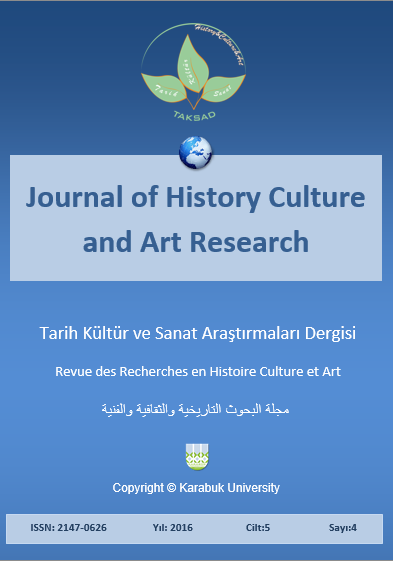Restating the Seyed Morteza’s Sarfah Theory
DOI:
https://doi.org/10.7596/taksad.v5i4.624Anahtar Kelimeler:
Sarfah Theory- Textual Miraculous Aspects- Miraculous Way- Challenging Quran- The Eloquence of Quran- The Poetry of Quran- News of Unseen- The Congruity of Quran.Özet
During the third to sixth century, a theory about miraculous aspects of the Quran, named the Sarfah Theory, was proposed. Seyed Morteza was one of the eminent fans of this theory. Although he had been attracted to this theory by complying with the Mu’tazilli System, he played the most significant role in developing this theory by his independent compilation named “Almouzeh-The Explanation”. His scientific domination over literature, poetry, language, jurisprudence and rules, prevents us from neglecting his theory, and ignore his reasons and challenges about Sarfah theory. The issue that someone like Seyed Morteza claims that the text of Quran is devoid of miracles and its miracles are outside of its text, needs to be precisely investigated. However, his exposition of Sarfah cannot be accepted, but as it seems a new exposition of this theory can be provided and generally a good advocation of Seyed Morteza’s theory can be presented. In this paper, we accompany Seyed Morteza and claim that the thaumaturgy of Quran has aspects outside of its text. But we also declare that this miracle is associated with the way of getting through Quran. This exposition of Sarfah would be that: God has denied the Quranic revelation gift for anyone but Prophet Muhammad.
Referanslar
Abousadi, S. (1988). Alansab. Catering and suspension Abdullah Baroud life. Beirut: House of al-Jinan, 1408 lunar calendar.
al-Baghdadi, ibn Ishaq. M. N. The index. The study of Reza Tajadod. Tehran, 135? solar calendar.
Ali ibn Hussein. S. M. (1991). Ammunition in the science of speech. A study of Sayed Ahmad Hosseini. Qom: Islamic Publishing Corporation of the group of teachers in Qom, 1411 lunar calendar.
Ali ibn Hussein. S. R. (2000). The status of the miraculous aspects of Quran. The study of Mohammad Reza Ansari. Mashhad: Islamic Research Academy, 1424 lunar calendar.
Athir, Alkram, I. A. (1966). Full of History. Beirut: House issued for printing and publishing House of Beirut for printing and publishing, 1386 lunar calendar.
Badawi, A. R. (1997). Islamist doctrines. Beirut: House of Ilm Lilmalayin.
Baghdadi Ismail P. (1951). Gift for those who know the names of the authors and the works of classifiers. Istanbul: Venerable knowledge agency.
Fakhr, R. (2003). The end of the brief in the familiar miracles, House of Sader, Beirut, 1424 lunar calendar.
Ghazi Zadeh, K. (1995). "Attitude to the theory of money." Journal of Mofid. Fall 1374 solar calendar, volume 3.
Hanbal, A. I. (No date). Musnad Ahmad. Beirut: House of Sader, BiTa.
Homsi, N. (1995). The history of the idea of miracles in the Holy Prophet since the mission until the present era, Damascus, promotion, 1375 solar calendar.
Jahiz, Othman A. A. G. (1996). Animal. Achieve Abdul Salam Mohammed Haroun. Beirut: House of generation publisher, 1416 lunar calendar.
Muhammad. A. Z. (1998). The great miracle of the Quran. Cairo, House of Arabic Though, 1418 lunar calendar.
Rafii, M. S. (1990). Miracles of the Qur'an and prophetic eloquence, Beirut, House of Arabic Books, 1410 lunar calendar.
Rafii, M. S. (2000). Miracles of the Qur'an and prophetic eloquence, Beirut, House of scientific books, 1421 lunar calendar.
Shahry, ibn Ma’ada Shahry. A. R. (1997). Utterances on Sarfah, Presentation and criticism. Saudi Arabia: House of ibn Jozi, 1417 lunar calendar.
Tabari, A. M. (1991). Comprehensive statements on the interpretation of Quran. Beirut: House of knowledge, 1411 lunar calendar.
Tabatabaei, S. M. (1997). Tafsir al-Mizan. Qom: Publications Office of the Islamic Society of Seminary Teachers of Qom, 1417 lunar calendar.
Tehrani, A. B. (1983). Pretext to Shiites categories. Beirut: House of lights, 1403 lunar calendar.
Yaghub, J. Study the Sarfah theory in Quran being as a miracle, http://www.jafarinia.com/safahat/matnha/matn_ketabha/sarfa.Htm
İndir
Yayınlanmış
Nasıl Atıf Yapılır
Sayı
Bölüm
Lisans
Tarih Kültür ve Sanat Araştırmaları Dergisi'nde yayımlanan tüm çalışmalar Creative Commons 4.0 CC-BY lisansı ile lisanslanmıştır.
Bunları yapmakta özgürsünüz:
- Bu eseri her boyut ve formatta paylaşabilir — kopyalayabilir ve çoğaltabilirsiniz.
- Materyalden Adapte et — karıştır, aktar ve eserin üzerine inşa et
- her türlü amaç için, ticari amaç da dahil
Alttaki şartlar altında:
Atıf — uygun bilgiyi, lisansa linki, and ve değişiklik yapıldıysa değişiklik bilgisinivermelisiniz. Sizi veya kullanımınızı lisansörün onayladığı bilgisini içermemek kaydıyla, size uygun şekilde bu işlemleri gerçekleştirebilirsiniz.
AynıLisanslaPaylaş — Eğer materyali karıştırdınızsa, aktardınızsa ya da materyalin üzerine çalıştınızsa, ancak aynı lisans ile dağıtabilirsiniz.
- Ek sınırlamalar yoktur — Lisansın izin verdiği hakları başkaları üzerinde kanunlarla ya da teknolojiyikullanarak sınırlayamazsınız.







